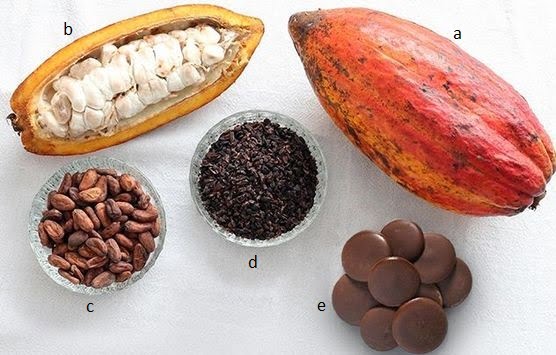Cacao beans are the seed obtained from the pods of the plant Theobroma cacao tree. The processing of cacao beans to obtain cocoa liquor and cocoa butter and cocoa powder includes series of steps of processing.

Fermentation: After harvesting of cacao pods, beans are carefully removed out of those pods and are allowed for fermentation. Fermentation of beans prevent germination of cocoa beans and allows required chemical changes to take place. Fresh cacao beans with some pulp in it are heaped together at room temperature, allowing rise in temperature for certain length of time (5 to 6 days). It should be noted that it is actually the pulp that is fermenting, not the beans.
During fermentation, yeast converts the pulp sugar into ethanol which is then converted to acetic acid by bacteria. Acetic acid is eventually reduced to carbon dioxide and water with release of heat. The fermentation of beans also converts the outer shell of the beans from fresh green to the characteristic brown color of chocolate. This is because as the beans die, enzymes are released, breaking up the cell structure allowing oxidation to occur and thus changing the color.
During later stage of fermentation, when temperature reaches 45°C, bacteria starts producing lactic acid along with acetic acid. These acids do not produce final chocolate flavor by themselves but plays key role in reaction for developing flavor during roasting. Although the bacteria themselves cannot enter the bean throughout the process due to its intact outer shell, the evolved chemicals can. This contribute to the flavor of the beans.
Drying: Fermented beans are dried to reduce their moisture content near to 7 %. Drying may be carried out by using solar dryer or sun drying naturally. During drying, care should be taken that beans are not contaminated from the environment. Drying of fermented beans prevents formation of molds and other microorganisms. However, over-drying is also not recommended. Over-drying of fermented beans make the beans brittle rendering them to be more difficult to handle during later stages of processing.
Cleaning: well dried cacao beans should undergo cleaning to remove any foreign matter (organic or inorganic). The outer shell of beans is the major source of microbial contamination during processing and in final product. Therefore, it is always recommended to remove outer shell of beans during cleaning before roasting of beans.
Roasting: Roasting of clean beans is carried out at 125 – 200°C temperature. High temperature not only kills microorganisms, also favors necessary chemical reaction to happen. Besides, roasting reduces the moisture content of beans to safe level ( 2%) that increases the shelf like and keeping quality of the beans. Roasting also facilitates loosening of shell for easy removal during subsequent stage of shelling. Generally fermented, dried and clean cacao beans are processed for roasting but in some cases, shells are removed prior to roasting and only nibs are roasted. In some processes, cocoa liquor are extracted out of the fermented, dried beans and the liquor is roasted.
Shelling: Roasted cacao beans are proceed to remove their outer shell and the shell are removed by sieving and suction. However, this process is not required if nib roasting or liquor roasting is performed in earlier stage.
Grinding and pressing: The perfectly fermented and roasted and clean cacao nibs are ground to obtain cocoa liquor. When the cacao nibs are grounded, cells are ruptured, releasing cocoa butter. When the cocoa liquor is pressed hot (90 – 100°C) in a filter press, cocoa fat (butter) is collected as a filtrate and cocoa cake as a residue. The cake is then milled to get cocoa powder. However, both cocoa butter and cocoa powder are equally used in chocolate industries.
Useful links:
Processing of cocoa beans
About Author
Name : Pratiksha Shrestha
pratiksha.shrestha2001@gmail.com
Ms. Shrestha holds masters degree in food engineering and bioprocess technology from Asian Institute of Technology (AIT) Thailand. She is currently working for Government of Nepal at Department of Food Technology and Quality Control (DFTQC), Kathmandu. She is also a teaching faculty in College of Applied food and Dairy Technology (CAFODAT) affiliated to Purbanchal university, Nepal.
